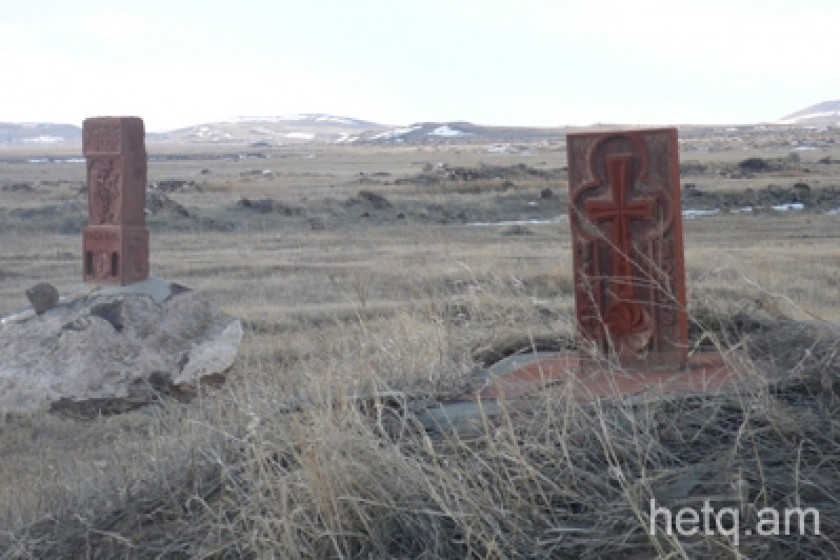
Armenia's Roadside Memorials: Will the "North-South Highway" Erase all Traces
The road to Gyumri, Armenia’s second city, passes through a repetitive set dry and empty of fields. For a passenger like me, it gets quite boring.
As a diversion, I try and read the inscriptions on the roadside monuments set up here and there to commemorate those who have died due to traffic accidents.
I ask my chauffeur friend what he feels as he drives past these numerous stone monuments and wreaths of flowers to honor traffic victims. He replies that they are a good thing, reminding other drivers of the fatal hazards awaiting those who do not obey the rules of the road.
Now, my work takes me outside Yerevan every two weeks or so, especially to Gyumri. Every time I make the trip, it seems that the number of these roadside monuments gets larger and larger.
I mention this observation of mine to my driver. His response is simple: “If these reminders didn’t exist the number of traffic fatalities would be much greater.” Go figure, I think to myself.
Many others I’ve spoken to share this belief. While, I can’t argue with the logic I still am inclined to disagree.
But there’s the flip side to this as well. Many have told me that these roadside monuments and ad-hoc memorials of flowers divert their attention while driving. Sometimes they even impart an impending sense of fear and foreboding.
Take the roads from Yerevan to Gyumri and Syunik. Regular drivers on these routes complain that certain sections are in terrible shape and present a number of hidden hazards. They claim that the lack of proper road signs only adds to the number of road accidents on these stretches.
I wanted to find out what the RA Road Police thought about all this and what measures they were taking to minimize the risks.
The police replied that in addition to the installation of speed cameras they also carry out road inspections every spring and fall. If they find areas of road in disrepair, reports are submitted to the appropriate agencies.
They didn’t say if their reports are ever acted upon; i.e. if proper warning signs are posted to alert drivers to the dangers lurking ahead.
In practice, all drivers can rely on for such information are the roadside memorials and wreaths of flowers. This is the scenario all over Armenia, but especially on the roadways leading from the Ararat Marz to Vayots Dzor and Syunik beyond.
I try to remember what my friends living overseas said when I asked them if they knew of another country where such roadside memorials were an accepted practice. They couldn’t come up with one country.
I shudder to think what our highways in Armenia would look like in a few years given the yearly rise in road accidents – a veritable graveyard of stones and flowers.
According to figures supplied by the RA Police, in 2011 and up to May of this year, 24 traffic accidents have been registered on the Yerevan-Yeraskh-Goris-Meghri-Iran highway, resulting in 6 fatalities and 39 injured. During the same period, 27 road accidents have been registered on the Yerevan-Sevan-Ijevan-Azerbaijan highway; resulting in 8 fatalities and 54 injured.
Back in the Soviet era, the road police would show off the crushed and mangled remains of cars to alert drivers to the risks involved of reckless and inattentive driving. This practice was removed from public practice a long time ago.
Instead, it is now up to the family and friends of road accident victims to remind others of the risks with their memorials and flowers.
I then wondered if prior permission was needed to erect such roadside memorials, so I wrote to the regional authorities of Aragatzotn, Shirak and Vayots Dzor – regions that boast the most monuments.
I wanted to know what the authorities thought about these memorials, or if they thought about them at all. Had anyone ever tried to steer through the regional bureaucracy in order to legally erect such a memorial to a loved one? Was there such a formal application procedure at all?
The answers I received were quite clear. No one had ever applied to the local authorities prior to erecting such memorials. It was a spontaneous exercise in expressing grief.
Even if a family member were to apply for such a permit, local authorities are not authorized to allot a patch roadway for any purpose.
I was told that due to safety reasons, such impromptu memorials along the road shoulders are not allowed. But it seems that no one cares once they are erected.
The general attitude of officials is – The family is already grieving, why should we give them something else to grieve about.
The private memorials, large and small, are left alone.
The “North-South Road Corridor” project will soon get underway in Armenia. It is supposed to upgrade and widen the existing highway from Yerevan to Gyumri and the Georgian border beyond according to international standards. The same will be done to the highway leading from Yerevan to Meghri in the south.
It is envisaged that the program will contribute to the socio-economic development in Armenia and expanded regional trade.
Local community leaders have been instructed not to clog up the planned roadway with any new structures. There must be 70 meters of empty space of both the right and left sides of the median.
So what will happen to these private memorials and stones erected by the grieving friends and families of traffic accident victims? Naturally, the directives of the government will win the day.
The new highway will bury all traces of prior road fatalities under the newly installed asphalt.
Local officials know all this and, in an attempt to avoid further grief, they should prevent the erection of any new memorials.
Perhaps the “North-South Road Corridor” project will help our people refrain from yet another objectionable custom.
 Videos
Videos Photos
Photos
Comments (4)
Write a comment